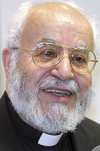Back in 2003, I posted a cautionary note advising people not to buy so-called “Monastery Icons” because they were made by members of a strange sect that blended Hinduism with Christianity. It changed its name several times and relocated every few years. Now they’re in California.
Just in case anyone had any lingering doubts about the nature of the group, its web site now describes them openly as a Hindu ashram. It’s good that they cleared that up.
The folks at St. John Cantius parish in Chicago must not have known about this when they presented Pope John Paul II (sorry, the newsletter link is broken now) one of the sect’s pseudo-icons.
(Update: Corrected the reference to the Holy Father; thanks to reader Hache who spotted a mistake.)
[2015 update: Now they’re in New Mexico, claiming to be Christians again, but still blending Christianity with Hindu beliefs.]

